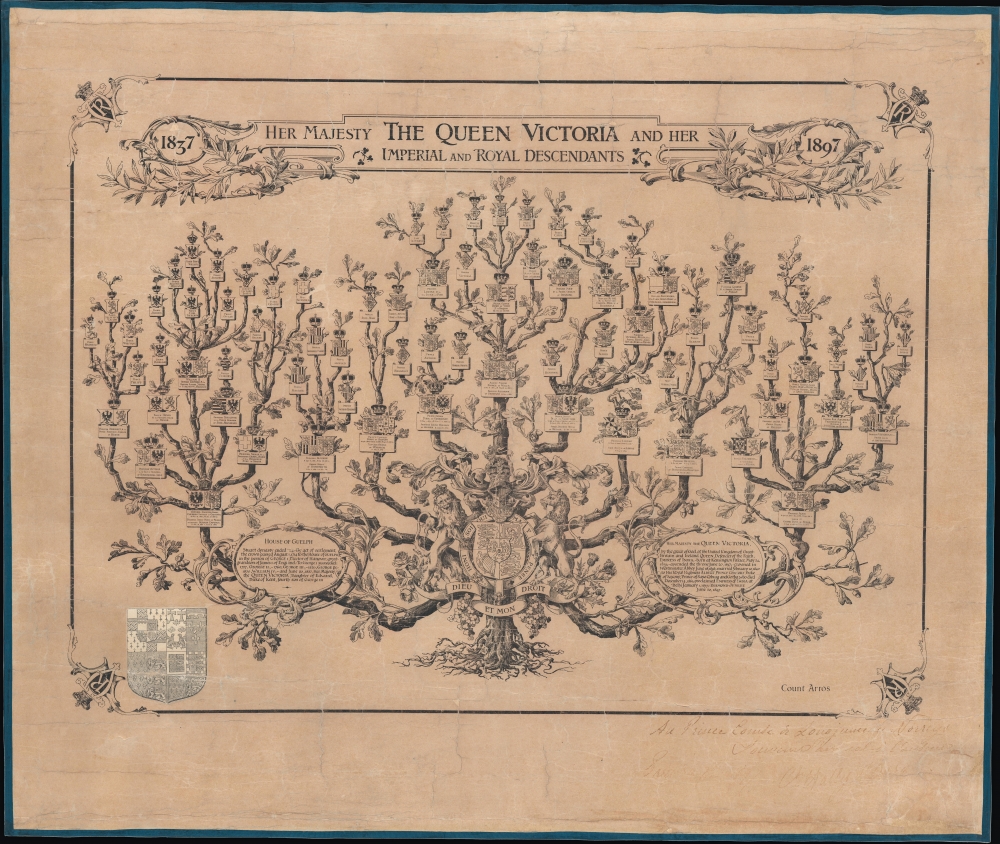This item has been sold, but you can get on the Waitlist to be notified if another example becomes available, or purchase a digital scan.
1897 Arros Family Tree of Queen Victoria (Diamond Jubilee)
QueenVictoriaFamilyTree-arros-1897$1,100.00

Title
The Queen Victoria Her Majesty and Her Imperial and Royal Descendants.
1897 (undated) 24.5 x 29.25 in (62.23 x 74.295 cm)
1897 (undated) 24.5 x 29.25 in (62.23 x 74.295 cm)
Description
This highly scarce 1897 work by one 'Count Arros' and 'engraved' by one 'Reymond' is a family tree of Queen Victoria, created in tandem with her Diamond Jubilee.
The only other example of this work that we have been able to locate is cataloged by the Mary Evans Picture Library in London. Other works that were conceptually similar to the present family tree were published at the same time and with the earlier Golden Jubilee in 1887, but few if any were as large and ornate as the present work.
A Closer Look
This family tree takes Queen Victoria as the 'trunk,' with explanations of her own biography and the House of Guelph, to which she belonged, appearing on either side at the bottom. The lower, larger branches of the tree are the nine children she had with Prince Albert of Saxe-Coburg and Gotha, including Victoria, Empress of the German Empire and mother of the last German emperor, Wilhelm II, who appears at left near center. Higher up the 'trunk' is Albert-Edward, the future Edward VII (r. 1901 - 1910), his son George (George V, r. 1910 - 1936), and his own sons Edward Albert (Edward VIII, R. 1936) and Albert (George VI, r. 1936 - 1952). The branches of the tree demonstrate the close familial connections between the royal houses of Europe, in particular the British monarchy and the noble families of the German lands, not only the House of Hohenzollern but also those of other duchies and territories that were incorporated into the German Empire. Links to the Danish and Russian royal families are also shown. Each individual's name, title, and crest are presented, as well as their marriages and their birth and death dates. The coat of arms of the British monarchy sits at the base of the trunk, while additional regalia, curiously colored differently than the rest of the sheet, is located at bottom-left.Queen Victoria's Diamond Jubilee
Queen Victoria's Diamond Jubilee was a grand celebration held in 1897 to mark the 60th anniversary of her accession to the British throne. It was a significant event, as she was the first British monarch to reach such a milestone (the only other being her great-great granddaughter, Elizabeth II, while her grandfather, George III, died just months short of his Diamond Jubilee, though by that time he was in terrible health and suffering from severe dementia). Celebrated on June 22, 1897, the event was celebrated throughout the British Empire, crowned by a grand procession with Queen Victoria riding in a carriage through London while being cheered by massive crowds. For the nobility of Europe, many of whom would not last long in their positions, she was the 'Grandmother of Europe,' given her extensive familial connections with other European royal families (including through her husband Albert, of the House of Saxe-Coburg and Gotha). For British subjects and the world, the event emphasized British power, with an empire covering roughly one-quarter of the planet's land and an industrial economy that spawned marvelous innovations in rapid succession. In retrospect, the event might have equally served as a high-water mark - the U.S. economy was already much larger than Britain's and tensions with other European powers, namely the German Empire, presaged the disaster that would come with the First World War.Publication History and Census
Both the engraver (lithographer) Reymond (whose name appears under the vines of the House of Guelph at left) and seeming creator of this work, 'Count Arros,' remain a mystery. Arros is common in southwestern France in the Pyrenees region, and an old minor noble family of that name did exist in the region, though their connection with the House of Hanover, if any, is unclear. Perhaps they were a distant relation from when the Plantagenet kings of England ruled southwestern France? But if so, there is little information on the family's subsequent history (one 'Baron' Jean-François d'Arros was a decorated naval officer in the latter days of the Ancien Régime). In any event, the makers' names and the partially legible manuscript note at bottom-right in French also suggests a French author. The text is difficult to read, but appears to indicate that the family tree was gifted to a prince, whose name is unclear, as a souvenir, likely from a noble relative, perhaps one that attended the jubilee. The artist has drawn a symbol among the roots of the tree, but its meaning is unclear.The only other example of this work that we have been able to locate is cataloged by the Mary Evans Picture Library in London. Other works that were conceptually similar to the present family tree were published at the same time and with the earlier Golden Jubilee in 1887, but few if any were as large and ornate as the present work.
Condition
Very good. Full professional restoration. Accompanied by original rollers.
References
Mary Evans Picture Library Picture No. 10473981 (of work in the National Archives).

